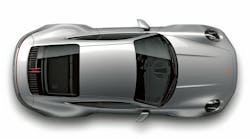Bob Bertsch is always observing, and always taking notes.
When the general manager walks through his body shop in Leesport, Pa., he makes sure to jot down any issue brought up by technicians, or painters, so he can plot a path toward a solution.
“I’m very process oriented,” explains Bertsch, who oversees the body shop at Steve Moyer Subaru. “If I see that something doesn’t work correctly, [I ask], ‘Do I need to redesign my process? Was the process not followed? Is there more training required?’ It usually falls in one of those parameters.”
Fifteen years ago, while working at a Nissan dealership in eastern Pennsylvania, Bertsch dealt with perhaps the most aggravating issue of his career. Employees weren’t being thorough with regard to the estimate process, which led to persistent paint booth bottlenecks.
Watching his paint booths constantly grind to a halt grated on Bertsch.
“If you have to stop that process to paint a bumper cap for a previously painted car, it just stops the whole process, stops the whole flow,” he says.
Fortunately for him, Bertsch took notes throughout that ordeal in 2003. And, as a result, his current facility runs far more smoothly, and issues like paint booth bottlenecks are now a rarity.
The Backstory
Fifteen years ago at that Nissan dealership, Bertsch frequently observed issues like this: a vehicle entered the paint booth, was painted, yet employees didn’t take note of the fact that bumper caps—or perhaps door handles, for example—also required painting.
At that point, the paint department had to hit the pause button, so to speak, while paint was re-mixed and the small item was painted. And that, Bertsch says, represented a fairly irritating obstacle that helped result in sluggish cycle times nearing 12 days in his shop.
The issue was widespread throughout the body shop staff, too. All too often, estimators would fail to take note of damaged tow-hook covers, or repair elements weren’t completely assigned within the facility’s management system. All of that contributed to slowing down the paint department.
The main culprit: Employees addressed the estimate process too hurriedly, often overlooking key pieces.
“You have to focus on making sure the estimate is complete,” Bertsch says, “from the moment the estimator writes it, to the repair planning, right up to when the vehicle is entered into the booth with all the parts, so the painter has a full repair plan in front of him.
“There’s a lot of room for error, so you just have to constantly inspect what you expect. And that’s why there’s managers.”
The Process
Before long, Bertsch developed an operation sheet that addressed the Nissan shop’s issues with regard to estimates.
He trained his employees to make sure that every paint-related request was detailed completely, especially often-overlooked elements like door handles.
“I know we’re in a paperless world today,” Bertsch says, “but there are some things that can’t replace a piece of paper. [Employees] need that in front of them … to make sure nothing’s forgotten.”
In addition to meeting with body shop staffers each morning (often one-on-one, in an undertaking that takes roughly 90 minutes in its entirety), Bertsch developed a process in which cars consistently enter and efficiently leave paint booths, helping his facility quickly reduce cycle time by two full days. Nowadays, while his refinish department manager keeps an eye on baking in one booth, he sets up color for the next vehicle he’ll paint, prior to its arrival to a booth. In short, at Bertsch’s current dealership, the paint department rarely experiences any wasteful down time.
“The idea is to always have a car going into the booth,” he says.
Yet, in a working environment where speed is essential, Bertsch has occasionally observed employees get too consumed with elements like cycle time.
“They’re trying to get cars through as fast as possible,” he notes. “But we can’t forget about the quality. So, sometimes you’ve got to slow down a little bit … It’s just a matter of making sure everybody reads those estimates, and is thorough.”
The Results
These days, at Moyer Subaru, Bertsch oversees a collision repair staff of 20, in a 24,000-square-foot facility. And, his department—which includes an attentive, driven lead painter—runs smoothly.
Paint department bottlenecks are a thing of the past for Bertsch; he has boosted his paint booth efficiency 130 percent since implementing the use of his operation sheet, and seen average vehicle output increase by 70 cars per month.
“My painter is all about time, and getting vehicles done,” Bertsch explains. “He makes sure he has a color match all ready and color mixed before the car comes into the booth. … Because it’s his goal to increase his efficiency.”
Moyer Subaru’s general manager of collision services—who now oversees a shop with a
cycle time of 7 days, and a CSI score of approximately 93—concentrates on coaching employees on the importance of following a process.
“If you don’t stay in tune with that, stuff falls through the cracks real quick,” Bertsch says. “And that affects cycle time, and that also affects that bottleneck in the paint booth.”



